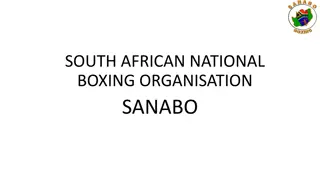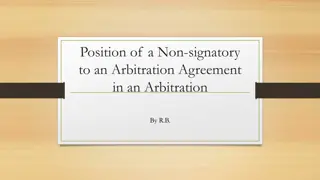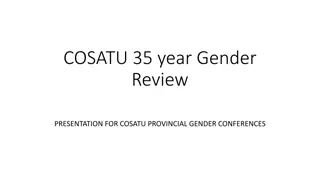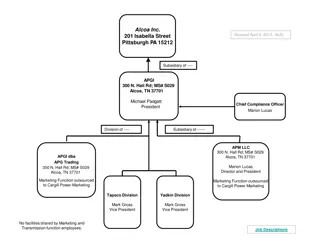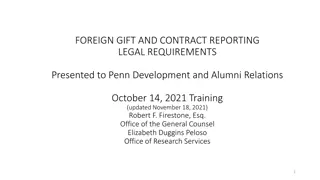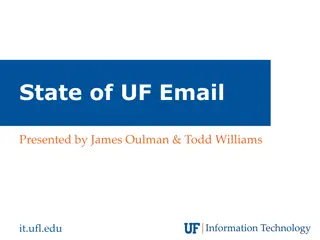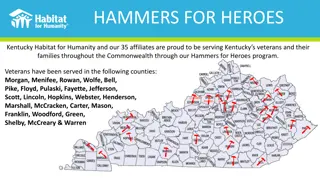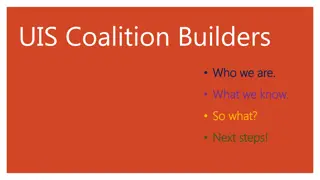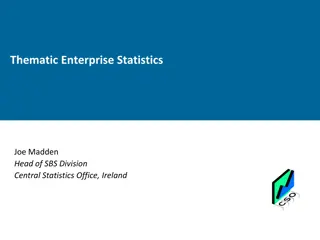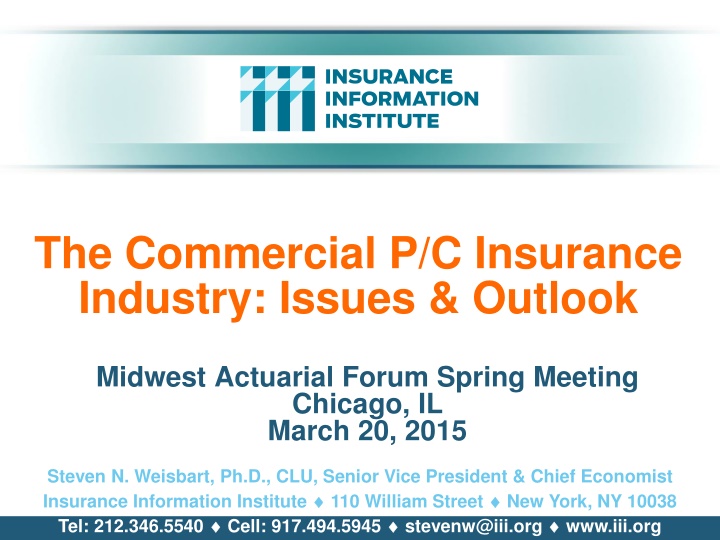
Analysis of Commercial P/C Insurance Industry Trends and Outlook
Explore the financial updates, profitability, and combined ratios of the Property & Casualty (P/C) insurance industry from 1991 to 2014. The analysis includes insights on net income trends, return on equity, profitability shifts over different periods, and the impact of catastrophic losses on the industry's performance.
Download Presentation

Please find below an Image/Link to download the presentation.
The content on the website is provided AS IS for your information and personal use only. It may not be sold, licensed, or shared on other websites without obtaining consent from the author. If you encounter any issues during the download, it is possible that the publisher has removed the file from their server.
You are allowed to download the files provided on this website for personal or commercial use, subject to the condition that they are used lawfully. All files are the property of their respective owners.
The content on the website is provided AS IS for your information and personal use only. It may not be sold, licensed, or shared on other websites without obtaining consent from the author.
E N D
Presentation Transcript
The Commercial P/C Insurance Industry: Issues & Outlook Midwest Actuarial Forum Spring Meeting Chicago, IL March 20, 2015 Steven N. Weisbart, Ph.D., CLU, Senior Vice President & Chief Economist Insurance Information Institute 110 William Street New York, NY 10038 Tel: 212.346.5540 Cell: 917.494.5945 stevenw@iii.org www.iii.org
Insurance Industry: Financial Update & Outlook 2014 Was a Reasonably Good Year 2013 Was the Industry s Best Year in the Post-Crisis Era 2 2
P/C Industry Net Income After Taxes 1991 2014E 2005 ROE*= 9.6% 2006 ROE = 12.7% 2007 ROE = 10.9% 2008 ROE = 0.1% 2009 ROE = 5.0% 2010 ROE = 6.6% 2011 ROAS1 = 3.5% 2012 ROAS1 = 5.9% 2013 ROAS1 = 10.3% 2014 ROAS1 = 7.6% Net income rose strongly (+81.9%) in 2013 vs. 2012 on lower cats, capital gains $ Millions $80,000 $65,777 $63,784 $62,496 $70,000 $50,203 $60,000 $44,155 $38,501 $36,819 $50,000 $35,204 $33,522 $30,773 $30,029 $28,672 $40,000 $24,404 $21,865 $20,598 $20,559 $19,456 $19,316 $30,000 $14,178 $10,870 $20,000 $5,840 $3,046 $3,043 $10,000 $0 -$6,970 -$10,000 91 92 93 94 95 96 97 98 99 00 01 02 03 04 05 06 07 08 09 10 11 12 13 14E ROE figures are GAAP; 1Return on avg. surplus. Excluding Mortgage & Financial Guaranty insurers yields a 7.7% ROAS through 2014:Q2, 9.8% ROAS in 2013, 6.2% ROAS in 2012, 4.7% ROAS for 2011, 7.6% for 2010 and 7.4% for 2009. Sources: A.M. Best, ISO; Insurance Information Institute
Back to the Future: P/C Insurance Industry Profitability, 1950 2014* 1970-90: Peak ROEs were much higher in this period while troughs were comparable. High interest rates, rapid inflation, economic volatility all played roles ROE 1990-2010s: D j vu. Excluding mega- CATs, this period is very similar to the 1950-1970 period 1950-70: ROEs were lower in this period. Low interest rates, low inflation, Bureau rate regulation all played a role 25% 1977:19.0% 20% 1987:17.3% 2006:12.7% 1972:13.7% 1997:11.6% 15% 2013 10.4% 1950:8.0% 1966-67: 5.5% 10% 1959:6.8% 5% 2014:H1 7.6% 1969: 3.9% 0% 1992: 4.5% 1984: 1.8% 1975: 2.4% 1965: 2.2% 1957: 1.8% 2001: -1.2% -5% 14E 50 52 54 56 58 60 62 64 66 68 70 72 74 76 78 80 82 84 86 88 90 92 94 96 98 00 02 04 06 08 10 12 *Profitability = P/C insurer ROEs. 2011-14 figures are estimates based on ROAS data. Note: Data for 2008-2014 exclude mortgage and financial guaranty insurers. 2014 figure is through Q3. Source: Insurance Information Institute; NAIC, ISO, A.M. Best.
P/C Insurance Industry Combined Ratio, 2001 2014:Q3* Higher CAT Losses, Shrinking Reserve Releases, Toll of Soft Market Relatively Low CAT Losses, Reserve Releases Heavy Use of Reinsurance Lowered Net Losses As Recently as 2001, Insurers Paid Out Nearly $1.16 for Every $1 in Earned Premiums Relatively Low CAT Losses, Reserve Releases Avg. CAT Losses, More Reserve Releases 120 115.8 Sandy Impacts Best Combined Ratio Since 1949 (87.6) Cyclical Deterioration 110 Lower CAT Losses 107.5 106.3 102.4 101.0 100.8 100.8 100.1 99.3 98.4 100 97.9 96.7 95.7 92.6 90 2001 2002 2003 2004 2005 2006 2007 2008 2009 2010 2011 2012 2013 2014 * Excludes Mortgage & Financial Guaranty insurers 2008--2014. Including M&FG, 2008=105.1, 2009=100.7, 2010=102.4, 2011=108.1; 2012:=103.2; 2013: = 96.1; 2014:9M = 97.7. Sources: A.M. Best, ISO. 5
A 100 Combined Ratio Isnt What It Once Was: Investment Impact on ROEs A combined ratio of about 100 generates an ROE of ~7.0% in 2012/13, ~7.5% ROE in 2009/10, 10% in 2005 and 16% in 1979 Combined Ratio / ROE 18% 15.9% 110 106.5 14.3% 15% 12.7% 105 102.4 101.2 101.0 100.6100.1100.8 10.9% 12% 99.5 100 97.9 97.5 96.7 95.7 7.9% 9% 7.4% 95 9.6% 92.7 9.8% 6.2% 8.8% 7.4% 4.7% 6% 90 Lower CATs helped ROEs in 2013 4.3% 3% 85 80 0% 1978 1979 2003 2005 2006 2007 2008 2009 2010 2011 2012 2013 2014:Q3 Combined Ratio ROE* Combined Ratios Must Be Lower in Today s Depressed Investment Environment to Generate Risk Appropriate ROEs * 2008 -2014 figures are return on average surplus and exclude mortgage and financial guaranty insurers. 2014:9M combined ratio including M&FG insurers is 97.7; 2013 = 96.1; 2012 =103.2, 2011 = 108.1, ROAS = 3.5%. Source: Insurance Information Institute from A.M. Best and ISO Verisk Analytics data.
Return on Net Worth (RNW) All Lines: 2004-2013 Average Commercial lines have tended to be more profitable than personal lines over the past decade 30 25.6 25 Personal lines 18.4 20 13.4 13.2 15 9.2 8.9 7.9 7.8 10 7.1 7.1 6.6 4.9 5 0 -1.0 -5 Fire Allied Lines All Other Other Liability PP Auto Total All Lines Comm Auto Total Workers Comp Farmowners MP Homeowners MP Commercial MP Inland Marine Medical Prof Liability Source: NAIC; Insurance Information Institute. 7
RNW All Lines by State, 2004-2013 Average: Highest 25 States The most profitable states over the past decade are widely distributed geographically, though none are in the Gulf region 24 Profitability Benchmark: All P/C US: 7.9% 22 20.5 20 18.4 18 14.6 16 14.3 13.4 13.3 14 12.3 12.1 12.0 12.0 11.7 11.4 11.1 11.1 10.9 10.8 10.7 10.7 10.5 10.5 12 10.3 9.9 9.8 9.8 9.6 9.5 10 8 6 4 2 0 HI AK VT ME WY ND VA ID NH UT WA SC MA NC OH DC CA OR RI WV CT IA NE SD MT MD Source: NAIC; Insurance Information Institute. 8
RNW All Lines by State, 2004-2013 Average: Lowest 25 States 9.2 10 8.6 8.4 8.3 8.2 8.2 8.1 8.0 7.9 7.7 7.7 7.5 7.4 8 6.8 6.6 6.4 6.1 5.7 5.3 5.2 6 5.0 4.3 4 2.5 1.9 2 0 -2 -4 Some of the least profitable states over the past decade were hit hard by catastrophes -6 -8 -6.9 -10 -9.3 -12 -14 NM FL TX WI KS MN CO PA US AR IL IN AZ MO KY TN NV NJ GA NY DE MI AL OK MS LA 9 Source: NAIC; Insurance Information Institute.
Performance by Segment and by State 10 10
Net Premium Growth: Annual Change, 1971 2016F (Percent) 1975-78 1984-87 2000-03 25% Net Written Premiums Fell 0.7% in 2007 (First Decline Since 1943) by 2.0% in 2008, and 4.2% in 2009, the First 3- Year Decline Since 1930-33. 20% 2015-16F: 4.0% 2014E: 3.9%* 2013: 4.6% 2012: +4.3% 15% 10% 5% 0% -5% 71 72 73 74 75 76 77 78 79 80 81 82 83 84 85 86 87 88 89 90 91 92 93 94 95 96 97 98 99 00 01 02 03 04 05 06 07 08 09 10 11 12 13 14 15F 14F *Actual figure based on data through Q3 2014. Shaded areas denote hard market periods Sources: A.M. Best (historical and forecast), ISO, Insurance Information Institute. 11
Commercial Lines Combined Ratio, 1990-2015F* Commercial lines underwriting performance is expected to improve as improvement in pricing environment persists 122.3 125 118.8 120 Commercial Lines Combined Ratio 112.5 112.3 115 111.1 110.2 110.2 110.2 109.7 109.5 109.4 107.9 107.6 110 105.4 104.3 104.2 104.1 103.4 102.5 102.4 105 102.0 99.9 100 98.9 98.9 95 93.6 90 91.1 85 90 91 92 93 94 95 96 97 98 99 00 01 02 03 04 05 06 07 08 09 10 11 12 13 14F 15F *2007-2012 figures exclude mortgage and financial guaranty segments. Source: A.M. Best (1990-2014F); Conning (2015F) Insurance Information Institute. 12
Commercial Auto Combined Ratio: 1993 2015F 125 118.1 116.2 115.9 115.7 120 113.0 112.1 112.0 115 106.8 103.9 110 103.4 102.7 102.6 105 100 99.8 99.1 95 97.8 96.8 95.2 94.3 90 92.9 92.4 92.1 85 80 95 96 97 98 99 00 01 02 03 04 05 06 07 08 09 10 11 12 13 14F 15F Commercial Auto is Expected to Improve as Rate Gains Outpace Any Adverse Frequency and Severity Trends Sources: A.M. Best (1990-2014F);Conning (2015F); Insurance Information Institute. 13
Commercial Multi-Peril Combined Ratio: 1995 2015F CMP-Liability CMP-Non-Liability 125.0 122.4 130 121.0 120.1 119.8 119.0 125 117.0 116.8 116.2 116.1 115.3 115.0 115.0 113.6 113.1 120 112.0 108.5 108.4 115 105.5 104.9 103.1 102.5 102.1 110 101.9 100.7 105 100 99.4 99.0 98.7 95 97.7 97.3 97.6 96.1 95.4 93.8 90 94.2 94.0 89.8 89.0 85 84.1 83.8 80 95 96 97 98 99 00 01 02 03 04 05 06 07 08 09 10 11 12 13 14F 15F Commercial Multi-Peril Underwriting Performance is Expected to Improve in 2013 Assuming Normal Catastrophe Loss Activity *2013F-2012F figures are Conning figures for the combined liability and non-liability components.. Sources: A.M. Best; Conning; Insurance Information Institute. 14
General Liability Combined Ratio: 2005 2015F 112.9 110.8 115 107.1 110 104.1 103.9 103.0 101.4 105 99.8 99.0 100 95.1 94.2 95 90 85 80 05 06 07 08 09 10 11 12 13F 14F 15F Commercial General Liability Underwriting Performance Has Been Volatile in Recent Years Source: Conning Research and Consulting. 15
Direct Premiums Written: Comm. Lines Percent Change by State, 2007-2013 Top 25 States 100 91.1 Only 30 states showed any commercial lines growth from 2007 through 2013 90 Growth Benchmarks: Commercial US: 1.3% 80 Pecent change (%) 70 60 50 42.1 41.4 33.7 40 26.3 25.8 23.6 30 19.1 15.6 14.0 20 11.3 10.0 9.8 6.8 6.7 6.5 10 4.1 3.2 3.1 3.0 2.7 2.2 2.0 1.7 1.3 0.6 0 IA AK AR MA LA WI WY NJ VT NE KS MS NY US ND OK SD ID MN IN OH MO NM CT TX TN Sources: SNL Financial LLC.; Insurance Information Institute. 16
Direct Premiums Written: Comm. Lines Percent Change by State, 2007-2013 Bottom 25 States Nearly half the states have yet to see commercial lines premium volume return to pre-crisis levels 5 0.5 0.4 0.2 0.1 0 -0.5 -0.8 -0.9 -1.0 -1.1 -1.1 -1.9 -2.0 -2.1 -2.7 -5 Pecent change (%) -3.3 -3.7 -4.3 -4.9 -10 -10.7 -11.4 -11.7 States with the poorest performing economies also produced the most negative net change in premiums of the past 6 years -12.6 -12.7 -15 -13.6 -20 -22.4 -25 -25.1 -30 AZ WA VA AL WV PA GA CA NV RI MI HI IL FL KY ME DE MD NH NC SC DC OR CO UT MT Sources: SNL Financial LLC.; Insurance Information Institute. 17
Cyber Risk: a Rapidly Emerging Exposure for Businesses Also Growing Interest from Media & Public Policymakers 18 18
Data Breaches 2005-2014, by Number of Breaches and Records Exposed # Data Breaches/Millions of Records Exposed Millions 222.5 783 800 220 200 700 662 656 619 180 600 160 498 140 500 127.7 447 446 120 419 87.9 85.6 100 400 66.9 321 80 300 35.7 60 22.9 40 16.2 19.1 17.3 200 157 20 100 0 2005 2006 2007 2008 2009 2010 2011 2012 2013 2014 # Data Breaches # Records Exposed (Millions) The Total Number of Data Breaches Rose 28% While the Number of Records Exposed Was Relatively Flat (-2.6%) 19 * 2014 figures as of Jan. 12, 2014 from the ITRC. Source: Identity Theft Resource Center.
Worldwide Cybersecurity Spending, 2011- 2016F ($ Billions) $83.2 $85 12% $80 9.8% 10% $76.9 8.2% 7.9% 8.4% 8.2% $75 8% $71.1 $70 $65.9 6% $65 $60.0 4% Cybersecurity spending increased by an estimated $5.2B in 2014, $5.8B in 2015 and $6.3B in 2016 $60 $55.0 2% $55 $50 0% 2011 2012 2013 2014F 2015F 2016F Worldwide Cybersecurity Spending % Change from Previous Year Cybersecurity Spending Is Rising Sharply, Up by About 8%+ Annually through 2016 a Projected Increase of $12.1 Billion from 2014 to 2016 20 Source: Gartner Group; Insurance Information Institute; Adapted from Wall Street Journal: Financial Firms Boost Cybersecurity Funds, Nov. 17, 2014.
Data/Privacy Breach: Many Potential Costs Can Be Insured Costs of notifying affecting individuals Costs of notifying regulatory authorities Defense and settlement costs Data Breach Event Regulatory fines at home & abroad Lost customers and damaged reputation Forensic costs to discover cause Cyber extortion payments Business Income Loss 21 Source: Zurich Insurance; Insurance Information Institute
The Three Basic Elements of Cyber Coverage: Prevention, Transfer, Response Post-Breach Response (Insurable) Loss Transfer (Insurance) Loss Prevention Cyber risk management today involves three essential components, each designed to reduce, mitigate or avoid loss. An increasing number of cyber risk products offered by insurers today provide all three. 22 Source: Insurance Information Institute research.
I.I.I. Released its Second Cyber Report in 2014: Cyber Risk: The Growing Threat I.I.I. s 2nd report on cyber risk released June 2014 Provides information on cyber threats and insurance market solutions Global cyber risk overview Quantification of threats by type and industry Cyber security and cost of attacks Cyber terrorism Cyber liability Insurance market for cyber risk 3rd Report in Q2 2015 23
Investment Performance: A Key Driver of Profitability Depressed Yields Will Continue to Affect Underwriting & Pricing 24 24
Distribution of Invested Assets: P/C Insurance Industry, 2013 $ Billions All Other, 10% Bonds, 62% Cash, Cash Equiv. & ST Investments, 6% Total Invested Assets = $1.5 Trillion Stocks, 22% Source: Insurance Information Institute Fact Book 2015, A.M. Best.
U.S. Treasury 2- and 10-Year Note Yields*: Monthly, 1990 2015 9% Yields on 10-Year U.S. Treasury Notes have been essentially below 5% for over a decade. 8% U.S. Treasury 10-year note yields spiked 7% 6% 5% 4% 3% Recession 2-Yr Yield 10-Yr Yield 2% 1% 0% Jun-90 Since roughly 80% of P/C bond/cash investments are in 10-year or shorter durations, most P/C insurer portfolios will have low-yielding bonds for years to come. Jun-91 Jun-92 Jun-93 Jun-94 Jun-95 Jun-96 Jun-97 Jun-98 Jun-99 Jun-00 Jun-01 Jun-02 Jun-03 Jun-04 Jun-05 Jun-06 Jun-07 Jun-08 Jun-09 Jun-10 Jun-11 Jun-12 Jun-13 Jun-14 *Monthly, constant maturity, nominal rates, through February 2015. Sources: Federal Reserve Bank at http://www.federalreserve.gov/releases/h15/data.htm. National Bureau of Economic Research (recession dates); Insurance Information Institutes. 26 26
Book Yield on Property/Casualty Insurance Invested Assets, 2007 2016F (Percent) 4.6 Book yield in 2014 is down 114 BP from pre-crisis levels 4.42 4.4 4.19 4.2 3.95 4.0 3.74 3.71 3.8 3.52 3.6 3.38 3.4 3.28 3.20 3.13 3.2 3.0 07 08 09 10 11 12 13 14E 15F 16F The yield on invested assets continues to decline as returns on maturing bonds generally still exceed new money yields. Interest rate increases are unlikely until mid-to-late 2015, and increases are expected to be small for a while. Sources: Conning.
Distribution of Bond Maturities, P/C Insurance Industry, 2004-2013 2013 15.6% 29.0% 11.9% 36.4% 7.1% 2012 16.5% 27.6% 9.8% 40.4% 5.7% 2011 15.2% 26.8% 10.3% 41.4% 6.3% Under 1 year 2010 16.3% 26.7% 11.1% 39.5% 6.4% 1-5 years 2009 16.2% 28.7% 11.7% 36.2% 7.3% 5-10 years 2008 15.7% 31.2% 12.7% 32.4% 8.1% 10-20 years over 20 years 2007 15.2% 33.8% 12.9% 30.0% 8.1% 2006 16.0% 34.1% 13.1% 29.5% 7.4% 2005 16.0% 34.1% 13.6% 28.8% 7.6% 2004 15.4% 32.5% 15.4% 29.2% 7.6% 0% 20% 40% 60% 80% 100% The main shift over these years has been from longer maturities to shorter maturities, but the 2013 data suggest a shift back has begun. The 2013 distribution resembles that at year-end 2009. Sources: SNL Financial; Insurance Information Institute. 28
Property/Casualty Insurance Industry Investment Income: 2000 20141 Investment earnings are still below their 2007 pre-crisis peak ($ Billions) $60 $54.6 $52.3 $51.2 $49.5 $49.2 $50 $48.0$47.4 $47.1$47.6 $45.7 $39.6 $38.9 $38.7 $40 $37.1 $36.7 $30 00 01 02 03 04 05 06 07 08 09 10 11 12 13 14* Due to persistently low interest rates, investment income fell in 2012, 2013 and 2014. 1 Investment gains consist primarily of interest and stock dividends. *2014 figure is estimated based on annualized data through Q3. Sources: ISO; Insurance Information Institute.
P/C Insurer Net Realized Capital Gains/Losses, 1990-2014:Q3 Realized capital gains rose sharply as equity markets rallied in 2013-14 ($ Billions) $18.02 $16.21 $13.02 $11.43 $10.81 $20 $9.89 $9.82 $9.70 $9.24 $9.13 $8.92 $8.76 $15 $7.04 $6.63 $6.61 $6.18 $6.00 $5.85 $4.81 $3.52 $2.88 $10 $1.66 $5 $0 -$1.21 -$5 -$10 -$7.90 -$15 -$20 -$19.81 -$25 90 91 92 93 94 95 96 97 98 99 00 01 02 03 04 05 06 07 08 09 10 11 12 1314:Q3 Insurers Posted Net Realized Capital Gains in 2010 - 2014 Following Two Years of Realized Losses During the Financial Crisis. Realized Capital Losses Were a Primary Cause of 2008/2009 s Large Drop in Profits and ROE Sources: A.M. Best, ISO, Insurance Information Institute. 30
Property/Casualty Insurance Industry Investment Gain: 1994 2014E1 ($ Billions) $70 $64.0 $57.4 $59.4 $58.8 $58.0 $56.9 $53.4$56.2$54.2 $60 $55.7 $52.3 $51.9 $48.9 $47.2 $50 $45.3 $44.4 $42.8 $39.2 $40 $36.0 $35.4 $31.7 $30 $20 Investment gains in 2014 will rival the post-crisis high reached in 2013 $10 $0 94 95 96 97 98 99 00 01 02 03 04 05* 06 07 08 09 10 11 12 13 14E Total investment gains were flat in 2014 because low interest rates offset realized capital gains 1 Investment gains consist primarily of interest, stock dividends and realized capital gains and losses. * 2005 figure includes special one-time dividend of $3.2B; Sources: ISO; Insurance Information Institute.
Interest Rate Forecasts: 2015 2020 3-Month Treasury 10-Year Treasury Yield (%) 5% 4.2%4.3% 4.3% 3.9% 4% 3.2%3.3%3.4% 3.2% 2.7% 3% 2.4% 2% 1.6% 1% 0.3% 0% 15F 16F 17F 18F 19F 20F 15F 16F 17F 18F 19F 20F A normalization of interest rates is unlikely until 2017-18 a full decade after the onset of the Financial Crisis and Great Recession. Sources: Blue Chip Economic Indicators (3/15 issue); Insurance Info. Institute. 33
CAPITAL/CAPACITY Capital Accumulation Has Multiple Impacts 34 34
Policyholder Surplus, 2006:Q4 2014:Q3 ($ Billions) $700 Drop due to near-record 2011 CAT losses 2007:Q3 Pre-Crisis Peak $673.9 $671.6 $662.0 $653.3 $624.4 $650 $614.0 $607.7 $586.9 $583.5 $566.5 $600 $570.7 $567.8 $559.2 $559.1 $550.3 $544.8 $540.7 $538.6 $530.5 $550 $521.8 $517.9 $515.6 $512.8 $511.5 $505.0 $496.6 $490.8 $487.1 $478.5 $500 $463.0 $455.6 Surplus as of 9/30/14 stood at a record high $673.9B $437.1 $450 $400 06:Q4 07:Q1 07:Q2 07:Q3 07:Q4 08:Q1 08:Q2 08:Q3 08:Q4 09:Q1 09:Q2 09:Q3 09:Q4 10:Q1 10:Q2 10:Q3 10:Q4 11:Q1 11:Q2 11:Q3 11:Q4 12:Q1 12:Q2 12:Q3 12:Q4 13:Q1 13:Q2 13:Q3 13:Q4 14:Q1 14:Q2 14:Q3 The industry now has $1 of surplus for every $0.73 of NPW, close to the strongest claims-paying status in its history. 2010:Q1 data includes $22.5B of paid-in capital from a holding company parent for one insurer s investment in a non-insurance business . The P/C insurance industry entered 2015 in very strong financial condition. Sources: ISO, A.M .Best. 35
Premium-to-Surplus Ratio: 1985 2014* (Ratio of NWP to PHS) The larger surplus is in relation to premiums the lower the P:S ratio and the great the industry s capacity to handle the risk it has accepted $2.00 $1.75 Surplus as of 9/30/14 was $0.75:$1, a near-record low (at least in modern history) $1.50 $1.25 $1.00 9/11, Recession & Hard Market $0.75 $0.50 85 86 87 88 89 90 91 92 93 94 95 96 97 98 99 00 01 02 03 04 05 06 07 08 09 10 11 12 13 14* The Premium-to-Surplus Ratio Stood at $0.75:$1 as of 9/30/14, a Record Low (at Least in Recent History) * As of 9/30/14. Source: A.M. Best, ISO, Insurance Information Institute.
Alternative Capital New Investors Continue to Change the Reinsurance Landscape First I.I.I. White Paper on Issue Will Be Released Q1 2015 38 38
Global Reinsurance Capital (Traditional and Alternative), 2006 - 2014 Total reinsurance capital reached a record $570B in 2013, up 68% from 2008. But alternative capacity has grown 210% since 2008, to $50B. It has more than doubled in the past three years. 2014 data is as of June 30, 2014. Source: Aon Benfield Analytics; Insurance Information Institute.
Growth of Alternative Capital Structures, 2002 - 2014 Collateralized Re s Growth Has Accelerated in the Past Three Years. Collateralized Reinsurance and Catastrophe Bonds Currently Dominate the Alternative Capital Market. 2014 data is as of June 30, 2014. Source: Aon Benfield Analytics; Insurance Information Institute.
I.I.I. Will Release its First Report on Alternative Capital During Q1 2015 Issue of alternative capital in (re)insurance has received increased attention in recent years Significant structural changes in property catastrophe reinsurance space Questions addressed include: Sources of new capital Forthcoming: Q1 2015 Reasons/Drivers of growth New structures Impact of major triggering event(s) Impacts of higher interest rates Cat bond yield compression 41
Questions Arising from Influence of Alternative Capital What Will Happen When Investors Face Large-Scale Losses? What Happens When Interest Rates Rise? Does ILS Have a Higher Propensity to Litigate? How Much Lower Will Risk Premiums Shrink/ROLs Fall? Will There Be Spillover Into Casualty Reinsurance? Will Alternative Capital Drive Consolidation? 42
The Strength of the Economy Will Influence P/C Insurer Growth Opportunities Growth Will Expand Insurer Exposure Base Across Most Lines 43 43
Real U.S. Quarterly GDP Growth Since the Great Recession 5% 4% 3% 5.0% 4.6% 4.6% 4.5% 3.9% 3.9% 3.5% 2% 2.9% 2.7% 2.7% 2.5% 2.5% 2.3% 2.2% 1.8% 1.7% 1.6% 1% 1.3% 0.8% 0.1% 0% -1.5% -2.1% -1% -2% -3% 09:3Q 09:4Q 10:1Q 10:2Q 10:3Q 10:4Q 11:1Q 11:2Q 11:3Q 11:4Q 12:1Q 12:2Q 12:3Q 12:4Q 13:1Q 13:2Q 13:3Q 13:4Q 14:1Q 14:2Q 14:3Q 14:4Q Since the Great Recession ended, even 3% real growth (at an annual rate) in a quarter has been unusual. It happened only 7 times in 22 quarters, but 4 of those 7 were in the most recent 6 quarters. Data are quarterly changes at annualized rates. 2014:Q4 is revised estimate Sources: US Department of Commerce, at http://www.bea.gov/national/index.htm#gdp ; Insurance Information Institute. 44
NFIB Small Business Optimism Index January 1985 through January 2015 Source: National Federation of Independent Business at http://www.advisorperspectives.com/dshort/charts/indicators/Sentiment.html?NFIB- optimism-index.gif ; Insurance Information Institute. 45
Business Bankruptcy Filings: Still Falling (1994:Q1 2014:Q3) (Thousands) New Below pre- recession level 18 Bankruptcy Law Takes Effect Recessions in orange 16.0 16 15.0 14.6 14.5 11.512.914.3 14.2 14.0 14.0 14.0 13.9 12.913.8 13.6 13.5 13.4 13.2 12.013.1 14 13.0 12.9 12.9 12.8 12.6 12.7 12.4 12.4 12.3 12.2 11.7 11.6 11.1 12 11.0 10.6 10.3 9.210.4 10.4 10.3 10.0 10.0 9.9 9.8 7.28.08.79.7 9.7 9.5 9.5 8.18.79.5 9.5 9.4 10 9.3 9.3 9.2 9.2 9.0 9.0 8.9 8.8 8.5 8.4 8.4 8.3 8.2 8.2 8.1 7.8 7.6 7.6 8 7.3 7.0 6.7 6.4 5.66.3 6 5.3 4.14.9 4 2 0 94:Q1 Business bankruptcies in 2014 were below both the Great Recession levels and the 2003:Q3-2005:Q1 period (the best five-quarter stretch in the last 20 years). Bankruptcies restrict exposure growth in all commercial lines. 94:Q3 95:Q1 95:Q3 96:Q1 96:Q3 97:Q1 97:Q3 98:Q1 98:Q3 99:Q1 99:Q3 00:Q1 00:Q3 01:Q1 01:Q3 02:Q1 02:Q3 03:Q1 03:Q3 04:Q1 04:Q3 05:Q1 05:Q3 06:Q1 06:Q3 07:Q1 07:Q3 08:Q1 08:Q3 09:Q1 09:Q3 10:Q1 10:Q3 11:Q1 11:Q3 12:Q1 12:Q3 13:Q1 13:Q3 14:Q1 14:Q3 Sources: U.S. Courts at http://www.uscourts.gov/uscourts/Statistics/BankruptcyStatistics/BankruptcyFilings/2013/0913_f2q.pdf ; Insurance Information Institute 46
Index of Total Industrial Production:* A Near Peak as of December 2014 Many economists expect business investment to rise in 2015 110 105 100 95 90 85 December 2014 Index at 106.5 80 Peak at 100.82 in December 2007 (officially the 1st month of the Great Recession) Recession 75 70 65 60 Insurance exposures for industrial production will continue growing in 2015, and commercial insurance premium volume with them. Y-o-Y growth to December 2014 was 4.6%. Both production and premium volume growth for 2015 should exceed this. *Monthly, seasonally adjusted, through December 2014 (which is preliminary). Index based on year 2007 = 100 Sources: Federal Reserve Board at http://www.federalreserve.gov/releases/g17/ipdisk/ip_sa.txt . National Bureau of Economic Research (recession dates); Insurance Information Institute. 47 47
Labor Market Trends We re Now Gaining Jobs at a Strong Pace, Mainly in the Private Sector 49 49
Monthly Change in Nonfarm Employment, 2011 2015* Average Monthly Gain Thousands 2011: 173,600 2012: 186,300 2013: 194,250 2014: 259,700 500 423 450 360 400 330 329 322 350 239295 286 280 274 300 250 249 243 237 236 226 225 225 221 221 217 214 213 212 250 203 203 149202 201 199 197 196 188 183 168 166 164 164 161 160 200 150 141 122 110 106 150 102 96 88 84 100 70 50 0 Jan-12 Jan-13 Jan-14 Jan-15 Jan-11 May-11 May-12 Mar-12 Mar-13 Mar-14 Mar-11 May 13 May 14 Jul-11 Jul-14 Jul-12 Jul-13 Sep-11 Sep-12 Sep-13 Sep-14 Nov-11 Nov-12 Nov-13 Nov-14 If job growth continues at the recent pace we will add over a million new workers every four months. *Seasonally adjusted. Jan 2015 and Feb 2015 are preliminary data. Sources: US Bureau of Labor Statistics; Insurance Information Institute 50
Unemployment and Underemployment Rates: Still Too High, But Falling January 2000 through February 2015, Seasonally Adjusted (%) 18 "Headline" Unemployment Rate U-3 Unemployment + Underemployment Rate U-6 U-6 went from 8.0% in March 2007 to 17.5% in October 2009 16 14 12 U-6 was 11.0% in Feb. 2015. 10 8 Headline unemployment was 5.5% in February 2015. 4% to 6% is normal. 6 For U-6, 8% to 10% is normal. 4 2 Jan 00 Jan 01 Jan 02 Jan 03 Jan 04 Jan 05 Jan 06 Jan 07 Jan 08 Jan 09 Jan 10 Jan 11 Jan 12 Jan 13 Jan 14 Jan- 15 High unemployment and underemployment still constrain overall economic growth, but the job market is now clearly improving. Source: US Bureau of Labor Statistics; Insurance Information Institute. 51 51
Nonfarm Payroll (Wages and Salaries): Quarterly, 2005 2014:Q3 Billions $7,750 Latest (2014:Q3) was $7.46 trillion, a new peak--$1.21 trillion above 2009 trough $7,500 Prior Peak was 2008:Q3 at $6.54 trillion $7,250 $7,000 $6,750 $6,500 $6,250 Growth rates 2011:Q3 over 2010:Q3: 4.1% 2012:Q3 over 2011:Q3: 3.2% 2013:Q3 over 2012:Q3: 3.6% 2014:Q3 over 2013:Q3: 4.4% $6,000 Recent trough (2009:Q1) was $6.23 trillion, down 5.3% from prior peak $5,750 $5,500 05:Q1 05:Q2 05:Q3 05:Q4 06:Q1 06:Q2 06:Q3 06:Q4 07:Q1 07:Q2 07:Q3 07:Q4 08:Q1 08:Q2 08:Q3 08:Q4 09:Q1 09:Q2 09:Q3 09:Q4 10:Q1 10:Q2 10:Q3 10:Q4 11:Q1 11:Q2 11:Q3 11:Q4 12:Q1 12:Q2 12:Q3 12:Q4 13:Q1 13:Q2 13:Q3 13:Q4 14:Q1 14:Q2 14:Q3 Note: Recession indicated by gray shaded column. Data are seasonally adjusted annual rates. Sources: http://research.stlouisfed.org/fred2/series/WASCUR; National Bureau of Economic Research (recession dates); Insurance Information Institute. 52 52
U.S. Insured Catastrophe Loss Update 2014 Had Below-Average CAT Activity 54 54





